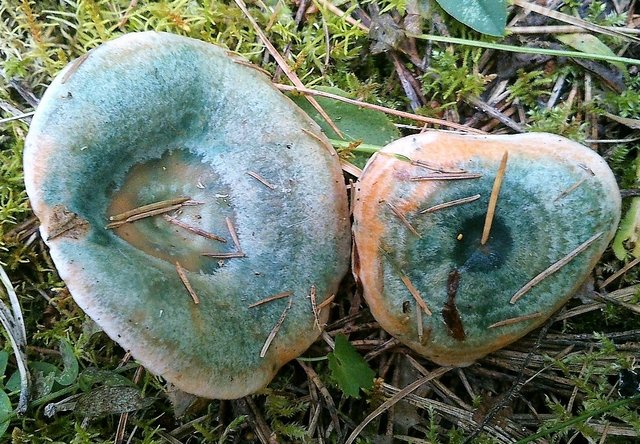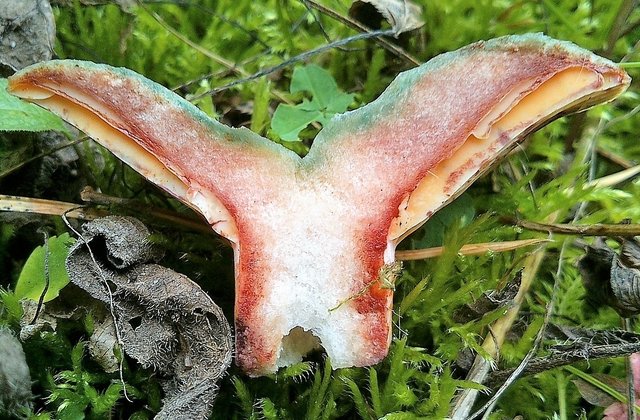Semi-red camelina (Lactarius semisanguifluus)
- Division: Basidiomycota (Basidiomycetes)
- Subdivision: Agaricomycotina (Agaricomycetes)
- Class: Agaricomycetes (Agaricomycetes)
- Subclass: Incertae sedis (of uncertain position)
- Order: Russulales (Russulovye)
- Family: Russulaceae (Russula)
- Genus: Lactarius (Milky)
- Type: Lactarius semisanguifluus (Semi-red camelina)
:
- Ginger green-red

The name “semi-red” (Lactarius semisanguifluus) indicates a difference from red camelina (Lactarius sanguifluus), this should be taken literally: not so red.
head: 3-8, sometimes 10, according to some sources it can grow, rarely, up to 12 centimeters in diameter. But more common is the average size, 4-5 centimeters. Dense, fleshy. In youth, convex, hemispherical, with a slightly turned up edge. With age – prostrate, with a depressed middle, funnel-shaped, with a thinner, slightly lowered or flat edge. Orange, orange-red, ocher. The cap clearly shows concentric green, dark green zones, which are clearer and thinner in young specimens. In older fungi, the green zones expand and may merge. In very adult specimens, the hat can be completely green. The skin on the cap is dry, in wet weather a little sticky. When pressed, it turns red, then acquires a wine-red color, then turns green again.
plates: narrow, frequent, slightly decurrent. The color of the plates in young mushrooms is pale ocher, light orange, later ocher, often with brownish and green spots.

Leg: 3-5, up to 6 centimeters in height and 1,5 – 2,5 centimeters in diameter. Cylindrical, often slightly narrowed towards the base. The color of the cap or lighter (brighter), orange, orange-pink, often with depressed orange, with age – greenish, green uneven spots. The pulp of the leg is dense, whole, when the fungus grows up, a narrow cavity forms in the leg.
Pulp: dense, juicy. Slightly yellowish, carroty, orange-reddish, in the center of the stem, if a vertical cut is made, lighter, whitish. Under the skin of the hat is greenish.
Smell: pleasant, mushroomy, with well-pronounced fruity notes.
Taste: sweet. Some sources point to a spicy aftertaste.
milky juice: Changes greatly in air. At first, orange, bright orange, carrot, then quickly, literally after a few minutes, it begins to darken, acquiring purple hues, then it becomes purple-violet. The taste of milky juice is sweet, with a bitter aftertaste.
spore powder: light ocher.
Споры: 7-9,5 * 6-7,5 microns, ellipsoid, wide, warty.
The fungus (probably) forms mycorrhiza with pine, some sources indicate specifically with Scotch pine, so it can be found in pine and mixed (with pine) forests and park areas. Prefers calcareous soils. Grows singly or in small groups, from July to October, not abundant. In some countries, the mushroom is considered quite rare, it is not recommended to collect it precisely because of its rarity.
Information on the network, oddly enough, is contradictory. Most sources indicate half-red camelina as an edible mushroom, in terms of taste it is not much inferior to the more common pine camelina. However, there are also references to much lower taste qualities (Italy), and recommendations to boil the mushroom for at least 20 minutes, with mandatory rinsing after boiling, drain the broth (Ukraine).
- Spruce camelina – differs in the place of growth (under the spruces) and the color of the milky juice.
- Ginger red – does not have such pronounced zones on the hat.
Photo: Andrey.









